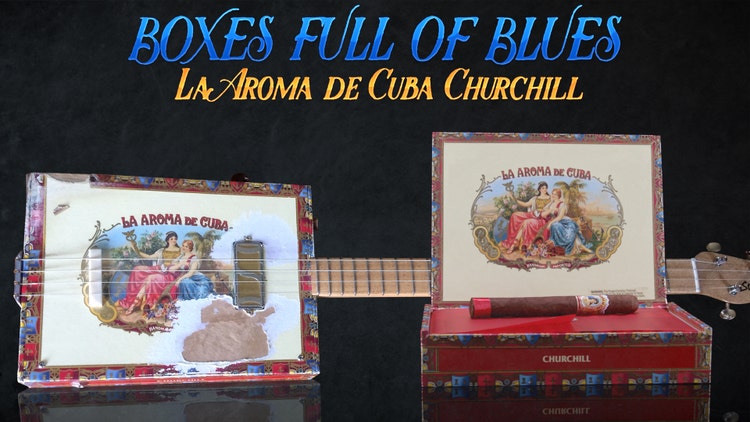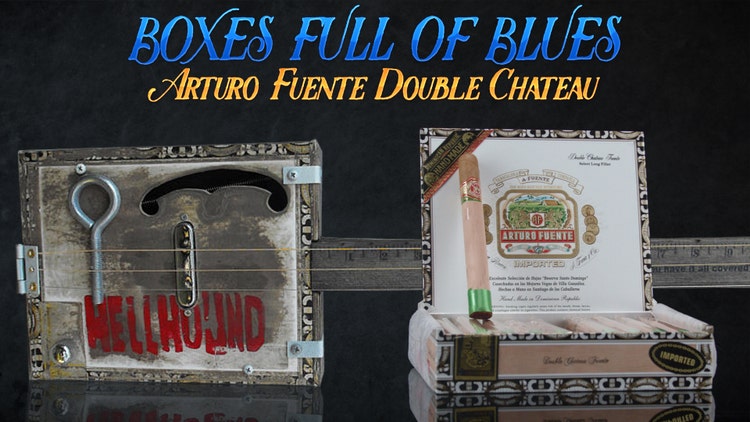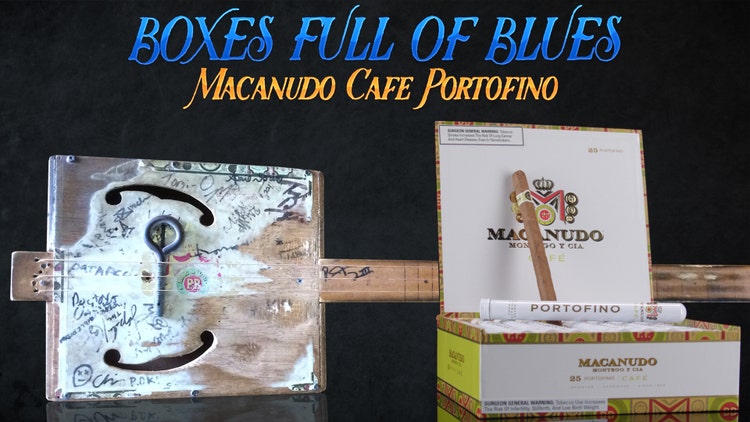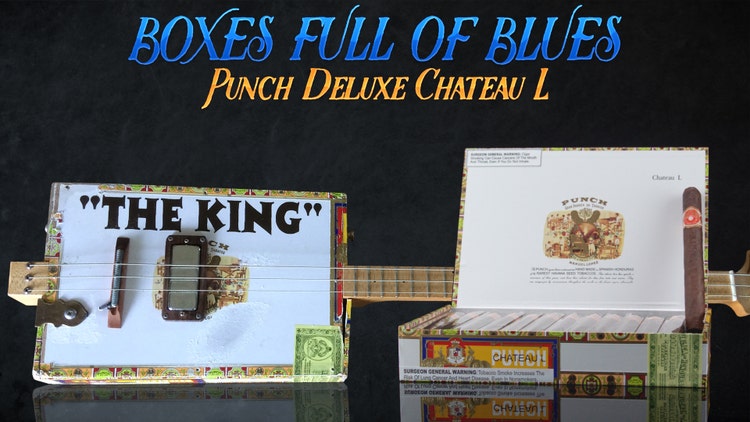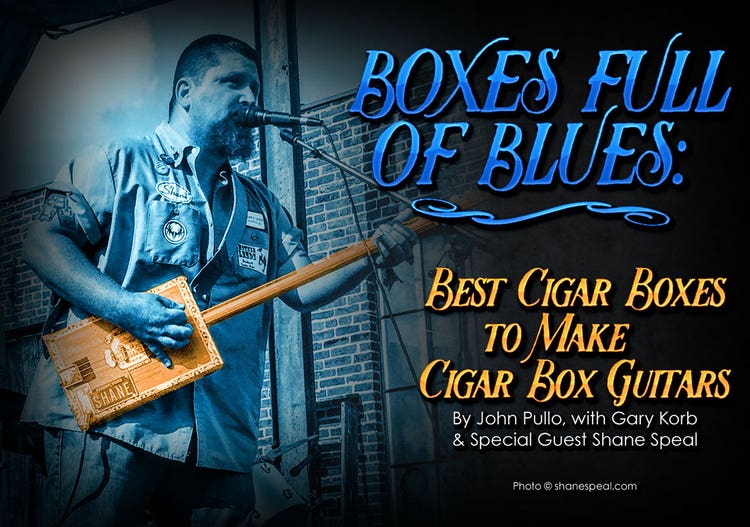
Boxes Full of Blues: The Best Cigar Boxes to Make Cigar Box Guitars
Boxes Full of Blues: The Best Cigar Boxes to Make Cigar Box Guitars
And a Look at the Cigars That Came in Them
By John Pullo, with Gary Korb – featuring Shane Speal
Cigar guys love everything about cigars; we Cigar Advisor guys happen to love our Blues, too. And today, we’re digging into both of these passions with the building and playing of cigar box guitars. This is pure Americana: there is both an art and a history to it, even though you don’t need to be a master craftsman to make one. But if you’ve wanted to try it for yourself, maybe you’ve wondered – what are the best cigar boxes to make cigar box guitars?
The truth that cigar box guitar builders know: you can make a cbg out of just about any brand of cigar box. No rules. But as Shane Speal has discovered over 25 years of building and playing cigar box guitars, there are certain cigar boxes many builders opt to use, just because these cigar boxes make great guitars. And when we had Shane in for one of our Facebook Live shows, Shane said, “Guys like me – who build cigar box guitars – I bet they would find it interesting to find out what the cigars are like, that originally came in those boxes, and maybe try those out.” Because, says Shane, “There’s something magical about when you’re building a cigar box guitar, actually smoking one of the cigars from the box that you’re building from.” He thinks it’s something that adds just a little more passion to the project.
Excellent idea.
So for our sit-down together, Shane showed us four great picks that just might be the best cigar boxes to make cigar box guitars:
Watch the video and you’ll get to hear what these 4 cigar boxes-turned-guitars can sound like.
In return, we brought Shane some little-known and seldom-used Cigar Advisor facts about the cigars that came in the boxes he selected – like the throwback appeal of La Aroma de Cuba, Macanudo’s surprises, and the secret to Punch Deluxe’s smooth, sultry smoke.
In a nutshell, here’s what happens: Shane plays guitar. Name checks some other great cigar box guitar builders you need to know. We talk beer and Broadleaf. Our collective Macanudo histories. Cigar lounges. His nickname. Punch Deluxe and whiskey. Lots more.
Watch now; the full transcript is below. And thanks to Shane for his hospitality.
– John & Gary
FULL TRANSCRIPT
John Pullo: So we’re downstairs in Shane Speal’s second shop – call it his office. I’m here with Gary Korb our editor for Cigar Advisor magazine. I’m John Pullo from Cigar Advisor magazine. With us…well, actually, we’re at his house – King of the Cigar Box Guitar, Shane Speal – and we’re going to look today at some of the guitar boxes, or some of the cigar boxes you like to use and talk a little bit about the cigars that came in them…and kind of get a feel for – again – cigar guys love everything about cigars. We like to talk about the cigars as much as we like to talk about what we can do with the boxes, too.
Shane Speal: Well this is kind of like, this was my request to you guys – because I’ve been building these cigar box guitars for 25 years, and there are certain boxes that you see a lot of them, we use them because they make great guitars. And I was wondering, what are the cigars that came in, kind of like, for the people that are also building the guitars – give them an overview. Kind of like a Cigars 101, and maybe they can try them out. There’s something magical about when you’re building a cigar box guitar, actually smoking one of the cigars that you’re building from. I don’t know what it is, it’s just – it’s all to bring more of this passion together.
John: Well if you were starting with La Aroma de Cuba…which is what I think what you have here. Your starting off with Big Flavor right up front. This is probably about a Churchill sized box. And we’ve got, this is the La Aroma de Cuba Immensa. This is the core line. So Nicaraguan cigar, from My Father, a tabacalera in Nicaragua. Probably about medium bodied…this is actually a Cuban revival brand. So if you’re working this box – you see the artwork that’s on here right is very, very similar to the Cuban brand that was revived from the late 1800s when My Father Cigars brought this box back to life, and brought this brand back to life.
Shane: Wow, I had no idea –
John: So it is a legit throwback.
Gary Korb: They like using the original neoclassical artwork. Because, you know, it comes from the original Cuban brand and it just gives it that classic sort of appearance and feel, like you’re getting a box of Cuban cigars.
Shane: So everything about this cigar is classic. (Oh yeah, definitely.) So you know, this guitar actually was made for me by St. Blues Guitars, out of Memphis. So if we’re talking about a classic cigar, then we’ll want to do some classic blues on here to kind of go with that…
Shane: (music)
John: So that soft feel, right? That kind of sultry feel to it? Nicaraguan tobaccos covered by Connecticut Broadleaf. Medium body, this is a great “step up” cigar. So if you’re only used to smoking mellow cigars, and you want to step up to something that’s got a little bit more body and flavor – so something like you were just playing, that’s got a little bit more depth, got a little bit more feel to it…that’s what this cigar is all about.
Shane: What kind of beer would you pair that with?
Gary: I’m not really a beer guy, but probably an IPA.
Shane: Oh, really? A bitter IPA for something like that?
Gary: Well, it’s got this sweet Connecticut Broadleaf wrapper on it.
Shane: I would think a good classic lager may go with that.
Gary: See, I’m not a beer guy. You would know more than I would.
John: Gary rips on the hard stuff. That’s why we love him.
Gary: Yeah it’s got some sweetness to it, that wrapper. And then you got that spicy, earthy Nicaraguan core in there.
Shane: That’s making my mouth water right now…
John: It’s got a nice little bit of bite to it.
Gary: Yeah, it’s bold – it’s a bold, full flavored smoke, and you probably want to play more of a heavier blues….
Shane: (Laughs) Where I kind of crank it up a little, I give it this…
Shane: (music) yeah…
Shane: OK I’ve got this guitar here. This was made for me by Thundaburke Cigar Box Guitars, and this is Arturo Fuente Double Chateau Fuente.
Gary: That’s a beautiful cigar.
Shane: And as you can tell, they aged the box to give it that old rat rod look to it. But tell me about the cigar first.
John: This is the Double Chateau. The Double Chateau Fuente comes in three wrappers: one is an Ecuador Connecticut. One is a sun grown Habano, which is a little bit more on the spicy side, and there’s also a Maduro which, again, it’s got that sweet component but a little bit more intense in the flavors. So, you mean, you’re looking at the first family of Dominican cigars – the Fuentes – been around for 100 plus years, this is the recipe for success here. A very mellow smoke. OK. A lot of times, Fuente is a good go-to just because you can pretty much find them anywhere. A good starter, especially in the Ecuadorian Connecticut.
Shane: So someone has never gotten into a cigar smoking, they want to try one out. This is a good…
Gary: Not only is it good, but it is a good buy. So if you’re new to cigars, you don’t want to spend a fortune – because you know what you’re getting into, you don’t want to spend ten dollars on a cigar. But for four or five bucks, even less depending on what size Fuente it is, you can have a really delicious cigar.
John: You can have this, this is cheaper than a ham sandwich. Seriously.
Shane: There we go!
John: This is cheaper than lunch. Like you said, you can go to a place where a cigar is going to cost you…especially depending where you go, ten dollars or more.
Shane: Right.
John: This is cheaper than drive through.
Gary: And it smokes like a ten dollar cigar. That’s the best part.
Shane: Nice. So you’re saying the wrapper will change the taste. You said the Maduro wrapper is sweeter…what were the other wrappers?
John: There’s a sun grown Habano, and there’s a Maduro. This was Ecuador Connecticut, so it’s got a lighter shade. So you can talk a little bit about the different flavors of Habano versus Maduro versus Connecticut.
Gary: Well, the Connecticut, what we have here, has kind of a natural sweetness and almost like, a hay-like quality to it a little bit. Like a grassiness…probably more so with genuine Connecticut-grown Connecticut than Ecuador Connecticut. The difference is, in Ecuador they have natural cloud cover. So you don’t need a tent to shade the plants – it’s done naturally by just the clouds. So that’s why the wrappers tend to be a little darker than the Connecticut Shade because they have these breaks in the clouds. A little sunlight gets through, and you know. So anyway, that, that’s kind of more, like I said, a sweet, aromatic wrapper. The sun grown is a little – I don’t want to say spicier, but it’s got a little more bite to it. And then the Maduro is sweet, naturally, because of the way it’s grown on the plant and aged and everything. So it’s dark. And the darker it is, usually the more sugar there is in the wrapper which makes it sweet.
John: It’s got a dark beer feel.
Shane: That’s interesting – the dark beer feel. For me, I’m always looking for a cigar that tastes like a porter, a Russian imperial stout.
John: So you know how they’ll say – I’m not a huge beer guy – but I know enough that just because a beer is dark doesn’t mean it’s strong. (Correct.) Same thing goes for cigars. (OK.) So just because this Fuente may be in a Maduro, doesn’t necessarily mean it’s stronger than the Habano – as a matter of fact it’s probably going to be a little more smooth, and a little more easy-smoking than the Habano.
Shane: But if it’s dark, it’s still going to have that sweeter mouthfeel…
John: Yes.
Gary: It’s going to have a little more natural sweetness, yeah. And that’s what I like. I like sweet cigars.
Shane: So we’re talking mellow and sweet….let’s see, if I take this…
Gary: Definitely mellow and sweet.
Shane: (music) Something like that…
John: Some good morning blues? (Oh yeah) A good morning cigar.
Gary: Chateau Fuente Blues.
Shane: Yep, nice.
Gary: And the Chateau line is kind of a cut above their main line. They have a cedar sleeve. That’s also how you tell the difference.
Shane: I was wondering about that, I didn’t know if that was a paper. That’s a cedar sleeve…
Gary: It’s cedar wood, and it gives it, it keeps that aging room bouquet to it, so it has a nice woody flavor to it as well. If you like a nice woody component – you probably do because you work with a lot of wood.
Shane: As I said out there, there is nothing like working in the woodshop – and when you cut into a cedar-lined cigar box, the sawdust mixed with the tobacco that has infused into the box is heavenly.
John: I think it’s time for the Portofino.
Shane: Ooooohhhh…the angels are starting to sing…Heavens open up, and a beam of light comes down because I’m about to have a religious experience here, and that is the Macanudo Portofino Cafe. THIS is the Macanudo Portofino Cafe cigar box guitar that I built in 1996, and I have been playing ever since. And that little cigar has inspired almost 10 albums of music, thousands of hours of performing or playing; you know, that little cigar has changed my life.
Gary: I’m not surprised. Because actually, when I first started getting into cigars, I smoked these all the time. I just loved, mostly, the aroma of that cigar – it just smells great. I guess you would know that. (Absolutely.) You smoke them. But it was very mellow in flavor, and sweet, and it just had that nice woodiness. It has a cedar lined – if I can get this out of here – a cedar lined tube, which gives you that nice cedar quality.
Shane: So coming in a tube, is almost like it’s a mini humidor.
Gary: Yeah, and also it’s great for travel. So you know, like you want to go down to…a golf course or wherever…if you play golf, or any outdoor kind of thing and it’s great because it’s convenient. But I tell you, that is really…it’s kind of a cool looking cigar.
Shane: Yeah it is…
Gary: It’s a panatela.
Shane: It’s very…Clint Eastwood.
Gary: Yeah, very like, 1960s James Bond, slick kinda thing. Macanudo Portofino – great, great cigar – great starter cigar, and a great change of pace cigar, too.
John: Portofino is, like Gary said, a great change of pace cigar. It’s also, I think, the golf classic. Because even though it’s a skinny cigar, it’s a longer cigar. You could pick it up, you could put it down. If you haven’t seen the beer girl for a couple of holes and you’re feeling a little dry, it’s not going to overpower you because it’s still on the mellow side. And plus in this tube, you just throw it, two or three of these, in your golf bag – you can smoke three of these, two of these in a round of golf. You’re ready to go.
Gary: You know what’s funny, maybe because I was just starting out smoking cigars and I didn’t have a sense of size, so to speak – but I don’t remember this being that thin – but it is. I thought it was thicker for some reason. But it’s just a great cigar.
Shane: So that’s my classic there.
Gary: Very kind of sinewy and slinky…
Shane: Now there’s only one thing that I would do…I would crank the reverb, I would pull back the tone, I would turn it up, and I would just give it one of these…
Shane: (music) There’s my religious experience right there.
John: Here’s a question – do you know any reggae? Because Macanudo got its start in Jamaica.
Gary: That’s right.
Shane: I was in Jamaica, and I saw so many Macanudos – so that makes sense.
John: Yeah, Macanudo was originally a Jamaican cigar. It’s now made in the Dominican Republic, and it used to have Jamaican tobaccos in it.
Gary: Jamaican tobacco’s excellent by the way, when it’s done right.
Shane: Really – well, they got excellent coffee there, too.
Gary: They have great soil, you know – and that’s what it’s all about. It’s always about the soil.
Shane: So we’re talking Punch Chateau. I’ve got this guitar, and again this is another one made by someone else. A kid named Casey Baron from Long Island, New York. He’s 18 years old. He’s a phenom – and he also builds incredible guitars. He made this and gave this to me last year. So this is the Punch Chateau Maduro…Maduro.
John: Ours must be lost in the mail.
Gary: So people make guitars for you, as well? It’s not just you? They want to impress you, is that it? Or honor you?
Shane: Sometimes we trade, sometimes people send them to me because I have my YouTube channel and you know, do that. There’s a brotherhood or a friendship that goes on in the whole cigar box guitar community and just about every person I know that builds guitars says they’ve probably given away at least 25 percent of the guitars they’ve built, myself included. You just, you build it, and you see someone that would like it, it’s like, “Here, have it.” Because you know you’re only have 20 bucks 30 bucks or something like that and you know it’s going to rock someone’s world.
Gary: It’s like that with cigars too, right? We do the same thing.
John: Yeah. The shorthand is BOTL, brother of the leaf. So it is this whole brotherhood of people getting together. They want to smoke. Look, some people like to smoke alone. Lot of people like to smoke together. That’s why you have a lounge – it’s like your safe, sacred space, right?
Shane: Amen.
John: So this is your…I’m trying to think how somebody had once described it, but basically like your temple of tobacco relaxation, right? So you get to just chill, hang out with some other people. You talk about cigars, you talk about nothing that has to do with cigars. It doesn’t matter. You want to watch a game, it’s on. You want to read a book, you want to read a magazine, occasionally chirp in on somebody’s conversation, whatever – you’re just sitting back, you’re relaxing, you’re enjoying a connoisseur quality product. And it’s relaxing and you know, you just hang out with other people that like to do the same. And you want to compare notes about stuff you smoked. You want to talk about, “Hey I just saw that great thing about the Dominican Republic, did you see…” or “Oh, so-and-so just got new stuff in from Punch.“
Gary: And how often have people come into our office and said, “Oh, I didn’t try that cigar.” It was like, “Oh yeah, here.”
Shane: But you know it’s just going to rock their world. It’s just, you do that. You want to just, share that awesome experience.
Gary: You want them to enjoy it. Exactly. Hopefully they’ll have the same experience you’ve had, and then you really, really bond, you know. Now you have that in common.
Shane: I do have to say, some of the best business meetings I’ve ever had, were with Ben “Gitty” Baker from CB Gitty, where we went to a local cigar lounge. Where we cut out early, and whenever I was up in New Hampshire visiting him. It’d be like two o’clock and he goes, “Alright we’ve done enough of this work. Let’s go.” And we sit and we have one or two cigars, and I swear to God we came up with some of the best ideas for musical instrument parts or kits or things like that over cigars, over anything. And I think it’s the relaxation as well, too.
John: Think about that the next time you see some poor soul slaving away over a book at Starbucks.
Shane: (laughs) So true! So true.
John: So this says, “the King.” Your nickname is the “King of the Cigar Box Guitar.” How did you get that name?
Shane: How did I get that name? I gave it to myself! There’s a reason for it. This was back before all of this took off, when the cigar box guitar was a dead instrument. It was dead to history…and I was on the Internet back in 2002, I think it was. And there was absolutely nothing on the Internet for cigar box guitars. So I created a page, one of those Geocities pages – remember Geocities? Yes! I created my own Web site. Free Web site, and it was…I showed free plans and it was very simple: how to build a cigar box guitar. And at the bottom I said, since nobody else would ever claim this title or be smart enough to claim it – or dumb enough to claim it – “I declare myself the king the cigar box guitar.” That’s like declaring yourself the “king of rhubarb pie chefs.” You know, I mean, it’s the dumbest thing in the world. And so I’ve kept it for the absurdity of it. I mean…
John: That’s awesome. It works.
Gary: So what about this cigar?
John: So this is, it’s actually called the Punch Deluxe Chateau ‘L.’ So that’s the full name. So this is the cigar that comes in this box. So this is a Honduran cigar that is wrapped in a Connecticut broadleaf. But it’s cured to what’s called Oscuro, which is Spanish for “dark.” So you have the typical range of the colors of a wrapper you’re used to seeing – you saw the Connecticut on that Fuente was a little bit lighter. Right. So we saw some of the maduros are like a brown. This is like a very, very dark brown. Some Oscuros are almost cured nearly black – but they’re super oily wrappers, this is all the natural oils and sugars…
Shane: Look at that – look at all the bumps on there, man…it’s like it has goosebumps.
John: And the sheen, and the tooth, yeah – this thing basically has goosebumps. It’s little pockets of oil that are on here. But this has a nice oily sheen to it. That’s on this Connecticut Broadleaf. It is a super fat Churchill. You smoke this thing, it gonna easily take you two and a half hours. Easily.
Shane: Aw, I love that.
John: Yeah. All-day sucker.
Gary: And you should always take your time when you smoke a cigar, too. Always just let it rest, you know. Enjoy the aroma, as it’s sitting in the ashtray or between your fingers. And then about a minute or so, take another hit off it, and just enjoy all that.
Shane: Let me tell you something I’ve learned about smoking cigars in my wood shop: my guitars take twice as long to build. Because I relax. The guitar, it’s like I get to a certain point and the cigar, and it’s just slowly burning there and it’s like, I just want to sit back and take a look at how I just sanded the neck, or how just did this, and it’s…zen. It’s absolute zen.
John: That’s what these do.
Shane: So these are dark, strong, and they last long.
John: Not as strong as you think. Punch has a reputation, that…as a very hardy cigar, real in-your-face, kind of. What was the tagline?
Gary: Punch…is a cigar that lives up to its name.
Shane: Nice.
John: But these…Punch Deluxe is more like a connoisseur-quality cigar. Very smooth, very woody…
Shane: Like how good whiskey is aged after a while…
John: You know, you take a belt of whiskey – it’s got that bite, and it, like, kind of dries you out a little bit? This is more of a really well-aged single malt, that goes down smooth. No burn, just good.
Shane: Aw, that would make me, like…so I’m doing the music that would go along with that, I would want to do something that…sometimes my band, when we start a song it’ll last 15 minutes. You know because you get into that…
Gary: That’s just the intro! (laughs)
Shane: Yeah, exactly! You dig that pocket and…
Shane: (music) That’s the type of thing where I just want to play that, all night long. You know? (music)
John: Two and a half hours of happiness, right there.
Shane: Beautiful. Of bliss.
With much thanks to Shane Speal for being part of this project.
